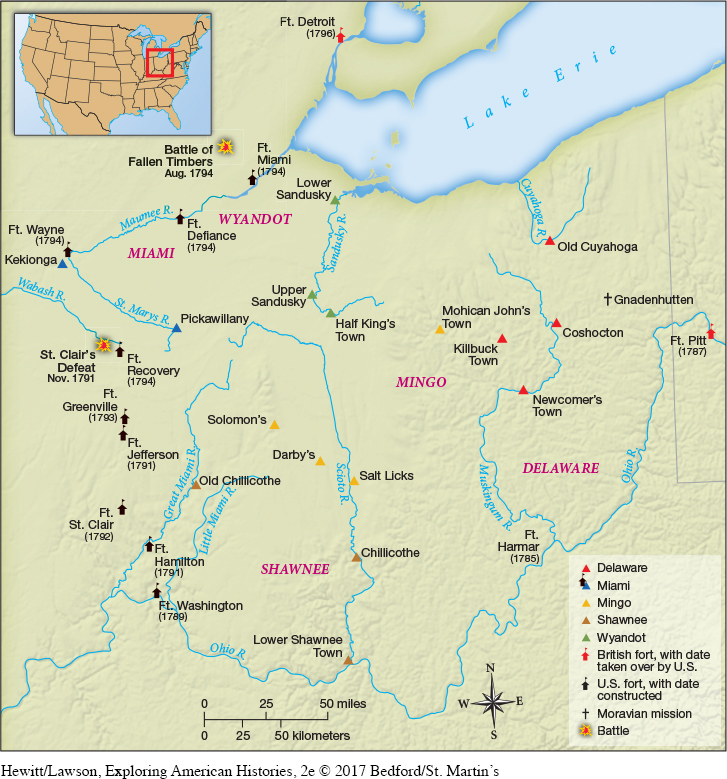Further Conflicts on the Frontier
In one area, Federalists shared a common concern: the continued threats to U.S. sovereignty by Indian, British, and Spanish forces. In 1790 Congress had passed the Indian Trade and Intercourse Act to regulate Indian-white relations on the frontier and to ensure fair and equitable dealings. However, the act was widely ignored.
The government’s failure to stem the flood of settlers into the Ohio and Mississippi River valleys proved costly. In 1790 Little Turtle, a war chief of the Miami nation, gathered a large force of Shawnee, Delaware, Ottawa, Chippewa, Sauk, Fox, and other Indians. This pan-Indian alliance successfully attacked federal troops in the Ohio valley that fall. A year later, the allied Indian warriors defeated a large force under General Arthur St. Clair (Map 7.2). The stunning defeat shocked Americans. In the meantime, Spanish authorities negotiated with Creeks and Cherokees to attack U.S. settlements on the southern frontier.

Washington decided to deal with problems in the Northwest Territory first, sending 2,000 men under the command of General Anthony Wayne into the Ohio frontier. In August 1794, Wayne’s forces attacked 1,500 to 2,000 Indians gathered at a British fort. In the Battle of Fallen Timbers, the pan-Indian warriors, led by Little Turtle, suffered a bitter defeat. A year later, the warring Indians in the Northwest Territory signed the Treaty of Greenville, granting the United States vast tracks of land.
Amid this turmoil, in November 1794, John Jay signed his controversial treaty with Great Britain. With Britain agreeing to withdraw its forces from the U.S. frontier by 1796, the treaty may have helped persuade Indian nations to accept U.S. peace terms at Greenville. Nonetheless, the Jay Treaty’s requirement that Americans make “full and complete compensation” to British firms for Revolutionary War debts without the British compensating U.S. merchants or slave owners for their losses nearly led Congress to reject it. In June 1795, however, the Senate finally approved the treaty without a vote to spare. Before Jay’s controversial treaty took effect, Spain agreed to negotiate an end to hostilities on the southern frontier of the United States. Envoy Thomas Pinckney negotiated that treaty, which recognized the thirty-first parallel as the boundary between U.S. and Spanish territory in the South and opened the Mississippi River and the port of New Orleans to U.S. shipping. Many Federalists, especially from the West and South, who opposed the Jay Treaty supported the Pinckney Treaty, which was ratified in 1796.
REVIEW & RELATE
How did events overseas shape domestic American politics and frontier policy in the 1790s?
What common concerns underlay the Whiskey Rebellion and Shays’s Rebellion? How did the U.S. government deal differently with each?
Exploring American HistoriesPrinted Page 228
Exploring American Histories Value EditionPrinted Page 170
Chapter Timeline